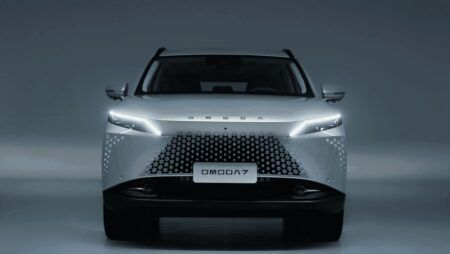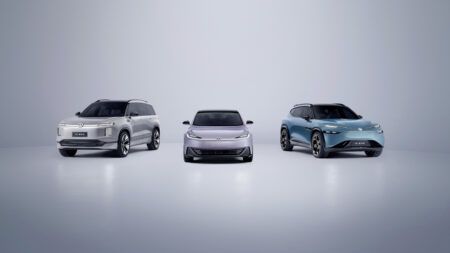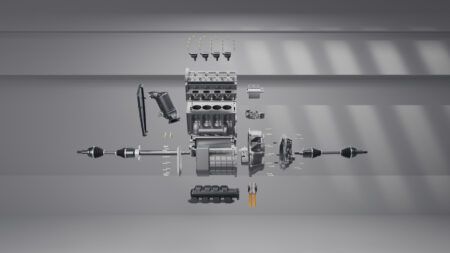The launch of a car is typically centered around the driving experience, where the dynamics, performance and potential of a brand’s latest model can be fully assessed and appreciated. However, with the LM – short form for Luxury Mover – Lexus has ensured that its newest car on the block was as much about the passengers as the driver. The auto maker describes it as a “flagship limousine with the greater spaciousness of an MPV” and the model options back that up.
It’s a fascinating vehicle in so much as it’s almost two cars in one, designed for two very different type of customer. First up is a version with four seats (the rear two being captain’s chairs), which you would expect to find on a private jet, or a high-end limousine. Touted as a mobile office, the four-seat LM passengers can be separated from the driver and front passenger by a thick glass panel (clear or opaque and retractable), which sits on top of a vast 48in HD screen. The seats fold almost flat and have been designed with the aid of passenger body movement analysis, based on motion capture and sensory evaluations. Therefore, the seats can counter head-sway, so that passengers maintain more stability than usual in an MPV, while also reducing low frequency vibrations.
 Meanwhile, the alternative is a seven-seat LM, with genuine space on the rear row of seats, which has historically been an area manufacturers have struggled to accommodate people in. Lexus sees this model being used by taxi firms and large families who want to transport themselves in the ultimate luxury.
Meanwhile, the alternative is a seven-seat LM, with genuine space on the rear row of seats, which has historically been an area manufacturers have struggled to accommodate people in. Lexus sees this model being used by taxi firms and large families who want to transport themselves in the ultimate luxury.
Whichever model it is – and whether behind the wheel or in one of the passenger seats – it is an incredibly comfortable place to be. And peaceful too. Lexus took inspiration from its LS to achieve a quietness that is akin to, in its own words, “walking through a silent wood in the open air”. All components that produced noise in the car were analyzed and measures were taken to prevent those sounds getting into the cabin. New sealings have been used, while clearances have been reduced – for example between the doors and the metal body panels – to help the vehicle’s structure. Furthermore, acoustic glass features outside help eliminate wind noise while inside, on the large panel in the four-door version, it reduces engine noise from the front of the vehicle. Adding extra attention to detail, noise-reducing wheels and tires have also been selected, the 19 inch forged alloys featuring an open resonator developed with Yamaha.
Back inside, Lexus has used active noise control technology to transmit reverse-phase sound waves through a speaker, in a bid to reduce low-frequency noise when the LM is on the move. In the four-seat version, non-sound absorbing five-layer headlining is used to ensure passengers can hold a conversation easily. Away from the noise cancelling and limiting improvements, ride quality was near the top of wish list for engineers working on the MPV. Powertrain, platform, body construction and noise and vibration elements were all fine-tuned to ensure that the passengers were kept as comfortable was possible while on the move.
“No matter how luxurious the interior design and features of a car are, passengers cannot truly spend their time in comfort without sophisticated underlying driving dynamics,” explains Takami Yokoo, the Lexus LM’s chief engineer. “The development team’s passion and care went into every detail of the vehicle, from the thoroughly honed chassis and body, supple suspension and aerodynamic design, to the seats that suppress body sway, the high-quality tailored interior and the numerous comfort features.”
 The LM is built on the Japanese company’s GA-K passenger car platform, as previously seen on the NX 350h and RX 350h models. It’s an important distinction that was highlighted as essential if the car is going to be taken seriously as a luxury transport option. The car’s main rival – the Mercedes-Benz V-Class – has its roots in the German manufacturer’s commercial vehicle products, but Lexus wanted to ensure this wasn’t the case here. From this base, engineers made the most of the platform’s low center of gravity and high body rigidity to develop a specific rear comfort drive mode, which adjusts the suspension characteristics and drive torque distribution, while suppressing vibrations at the same time. As a result, the car’s squat is reduced by 10 per cent and dive by 45 per cent. Body stiffness was increased by using laser screw welding, structural adhesives, bracing and other reinforcements. Such strengthening on the joints means reduced high-frequency vibrations, leading to better handling, ride comfort and overall NVH.
The LM is built on the Japanese company’s GA-K passenger car platform, as previously seen on the NX 350h and RX 350h models. It’s an important distinction that was highlighted as essential if the car is going to be taken seriously as a luxury transport option. The car’s main rival – the Mercedes-Benz V-Class – has its roots in the German manufacturer’s commercial vehicle products, but Lexus wanted to ensure this wasn’t the case here. From this base, engineers made the most of the platform’s low center of gravity and high body rigidity to develop a specific rear comfort drive mode, which adjusts the suspension characteristics and drive torque distribution, while suppressing vibrations at the same time. As a result, the car’s squat is reduced by 10 per cent and dive by 45 per cent. Body stiffness was increased by using laser screw welding, structural adhesives, bracing and other reinforcements. Such strengthening on the joints means reduced high-frequency vibrations, leading to better handling, ride comfort and overall NVH.
The suspension setup – relatively common MacPherson struts at the front and double wishbones with trailing arms at the rear – has been engineered for improved absorption and deflection of road inputs. The system’s compact dimensions also meant that interior space in the LM was maximized. Adaptive variable suspension is fitted as standard and sees frequency sensitive valves used for the first time in a Lexus. The result is modified damper performance at micro-amplitude and high frequency levels, reducing the influx from the road surface.
Sitting on the platform is Lexus’ hybrid powertrain that comprises a 2.5-litre in-line four cylinder engine with 187bhp and 239Nm of torque between 4,300 and 4,500rpm. There are front-wheel-drive and all-wheel-drive options, with both using a front-mounted 650V permanent magnet, synchronous motor, which puts out 178bhp and 270Nm of torque. The AWD LM uses a similar 650V motor on the rear, with 53bhp and 121Nm of torque. Both variations feature a lithium-ion battery with 259V and comprising nine modules. Maximum speed in EV mode is 77mph, while overall, the near 2,900kg LM will reach 118mph.
Given that overall weight – the LM returns a relatively modest 42.1mpg (39.2mpg for the four-seat version). Engineers have ensured the mass has been kept as low as possible thanks to the use of aluminum and thin-sheet steel on the external panels, which saved 18.5kg and 12.3kg respectively.





